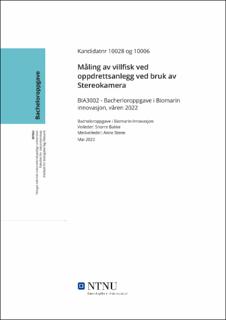| dc.contributor.advisor | Bakke, Snorre | |
| dc.contributor.advisor | Stene, Anne | |
| dc.contributor.author | Henningsen, Per-Christian | |
| dc.contributor.author | Åkre, Christoffer Stokkeholm | |
| dc.date.accessioned | 2022-07-26T17:19:37Z | |
| dc.date.available | 2022-07-26T17:19:37Z | |
| dc.date.issued | 2022 | |
| dc.identifier | no.ntnu:inspera:112030714:112693426 | |
| dc.identifier.uri | https://hdl.handle.net/11250/3008712 | |
| dc.description.abstract | Havbasert fiskeoppdrett påvirker miljøet og samfunnet både positivt og negativt. Gjennom den enorme veksten oppdrettsnæringen har hatt i Norge, har også miljøpåvirkningene blitt større og av viktigere betydning. Det settes stadig mer fokus på sikkerhet og det å være miljøvennlig. Et av punktene ved fiskeoppdrett det settes mer fokus på, er villfisk og hvordan denne blir påvirket av fiskeoppdrett. Ved å se på sammenhenger mellom biotiske og abiotiske faktorer, kan man se hva som påvirker villfisken, hvordan villfisken blir påvirket, og hva som kan gjøres i form av forebyggende miljøtiltak. Ved å analysere størrelse, utseende og atferd kan man få en generell forståelse for hvordan villfisken lever utenfor havbaserte oppdrettsanlegg.
Gjennom denne oppgaven vil fokuset være å måle nettopp dette. Det vil tas i bruk en kamerarigg ved et oppdrettsanlegg for å måle størrelsen til villfisk, i tillegg til artsidentifikasjon, utseende og atferd. Kamerariggen er bygget opp med inspirasjon i konseptet BRUV (Baited remote underwater video), og tar i bruk stereokamera som er en relativt ny kamerateknologi. Stereokamera er bruk av to eller flere kameraer samtidig for måling og analyse av objekter. Gjennom ulike tester med kamerariggen vil det dannes et grunnlag for hvorvidt kalibrering og grunnleggende tester må gjøres i vann eller kan forenkles og gjøres på land. Ved måling av villfisk i vann er det mange faktorer som spiller inn, både i forhold til årstid, dybde under vann, plassering og geografisk område.
Resultatene fra oppgaven viser at landkalibrering skiller seg negativt ut i forhold til vannkalibrering. Det er mye større unøyaktighet og feilmålinger med kalibreringen gjort på land kontra den gjort i vann. Dette er trolig på grunn av ulik lysbrytning i luft, kontra i vann. Etter måling av villfisk utenfor oppdrettsanlegg var det betydelig mengde av sei, og to tilfeller av torsk. Størrelsene på disse ble målt, og det ble analysert utseende og atferd. Det er tydelig at avstand og vinkel i forhold til kamera påvirker nøyaktigheten på målingene. Resultatene fra oppgaven viser at oppdrettsanlegg kan ha en viss påvirkning på villfisk i forhold til oppholdssted og størrelse, men det er uvisst om dette også påvirker atferd og utseende. | |
| dc.description.abstract | Sea-based fish farming affects the environment and society both positively and negatively. Through the enormous growth the aquaculture industry has had in Norway, the environmental impacts have also become greater and more important. There is an increasing focus on safety and being environmentally friendly. One of the areas of fish farming that has gained more focuse, is the wild fish outside the breeding-cages and how this is affected by fish farming. By looking at the connections between biotic and abiotic factors, one can see what affects the wild fish, how the wild fish are affected, and what can be done in the form of preventive environmental measures. By analyzing size, appearance and behavior, one can get a general understanding of how wild fish live outside sea-based fish farms.
Through this task, the focus will be on measuring precisely this. A camera rig will be used at a fish farm to measure the size of wild fish, in addition to identifying species, appearance and behavior. The camera rig is built with inspiration in the concept BRUV (Baited remote underwater video), and uses a stereo camera which is a relatively new camera technology. Stereo camera is the use of two or more cameras simultaneously for measuring and analyzing objects. Through various tests with the camera rig, a basis will be formed for whether calibration and basic tests must be done in water or can be simplified and done on land. When measuring wild fish in water, many factors come into play, both in relation to differents seasons, depth under water, location and geographical area.
The results from the thesis show that land calibration differs negatively in relation to water calibration. There is much greater inaccuracy and erroneous measurements with the calibration done on land versus the one done in water. This is probably due to different refraction in air, as opposed to in water. After measuring wild fish outside fish farms, there was a significant amount of Pollock, and two cases of Cod. The sizes of these were measured, and appearance and behavior were analyzed. It is clear that the distance and angle in relation to the camera affect the accuracy of the measurements. The results from the thesis show that fish farms can have a certain impact on wild fish in relation to location and size, but it is uncertain whether this also affects behavior and appearance. | |
| dc.language | nob | |
| dc.publisher | NTNU | |
| dc.title | Måling av villfisk ved oppdrettsanlegg ved bruk av Stereokamera | |
| dc.type | Bachelor thesis | |
